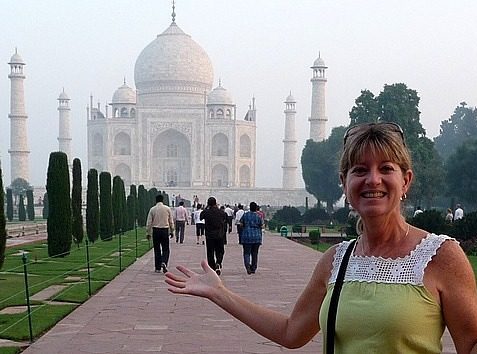Juan Prabang, Laos
So I arrived in the the UNESCO Heritage city of Luang Prabang (pronounced Juan Prabang), in northern Laos, early Tuesday morning and was immediately driven to the absolutely lovely Mekong Riverview Hotel. The hotel is located at the point where the Nam Khan River and the Mekong River meet. I was given a beautiful second floor room overlooking the Mekong and immediately spent some time relaxing on my deck enjoying the view.
Now a little about Luang Prabang. The city was formerly the capital of a kingdom of the same name. Until the communist takeover in 1975, it was the royal capital and seat of government of the Kingdom of Laos. The city is rather small and consists of four main roads located on a peninsula between the Nam Khan and Mekong rivers. The city is well known for its numerous temples and monasteries, french architecture, its laid back atmosphere and wonderful cuisine. And one of the the great aspects about the city being a UNESCO Heritage site is that no large buses or trucks are permitted on the roads so it results in a very peaceful atmosphere.
The most well known custom in the city is the giving of alms. Every morning, hundreds of monks from the various monasteries in the town walk through the streets of Luang Prabang collecting “alms” from the Buddhist faithful. “Alms” is the daily ritual of collecting food from lay Buddhists so that the monks may have their two daily meals. In Luang Prabang the tradition is to give the monks a handful of sticky rice, which they collect in a metal basket. This tradition has been shown on numerous travel channels and has caused the daily alms ceremony in Luang Prabang to become a tourist attraction (despite the fact that the alms ceremony can also be seen in almost every village in the area). I had mixed feelings about whether I would get up to see the ritual and decided I had a few days to make up my mind.
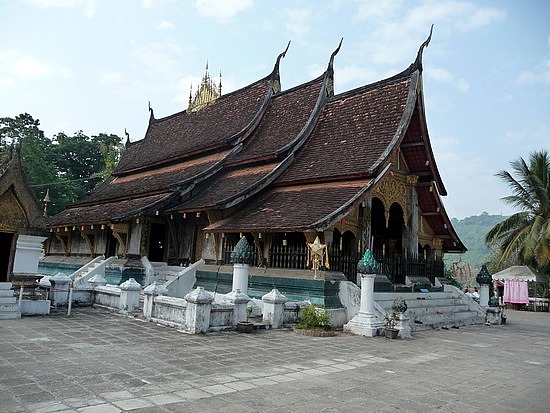
Anyway, by 12:30 p.m. my guide, “At”, arrived for my afternoon tour of some of the temples of Luang Prabang. And because the little town teams with temples, you see monks wandering the streets everywhere. I soon learned that At was a former novice (a monk in training) and monk in Luang Prabang, and that proved to be a huge bonus as the afternoon wore on.
Our first stop was the most magnificent temple in Luang Prabang, and a temple located only a block from my hotel, Wat Xieng Thong. The temple was built by King Setthathirat in 1560 and was simply beautiful. When we arrived, we lucked out and found the temple virtually deserted. It helped that it was lunch hour so we were able to make our way around the temple in virtual peace. We walked to the back of the temple and went into the royal funeral chapel that houses a 12 meter high chariot that was used to carry the king’s casket. In addition, we saw funeral urns for each of the royal family members and lovely glass murals depicting some rather erotic images from the Ramayana. (The Ramayana is one of the two famous tales from India. The story depicts the duties of relationships, portraying ideal characters like the ideal servant, the ideal brother, the ideal wife and the ideal king.)

Anyway, as we wandered through the funeral chapel, At pointed out to me a bundle of sticks and a board containing numbers and papers in the hole beside each number. Apparently it was a Buddhist fortune table. In order to have your fortune told, you kneel (I sat) and bang the bundle of sticks on the floor until one of the sticks pops out. The stick has a number on it that corresponds to one of the numbers on the board. Once you know your number, you take one of the pieces of paper from the hole on the board that corresponds to the number, and your future is revealed on the paper. I gave it a go and At told me I am in a period of good fortune (no kidding based on the luck I have had for the most part on this trip) and that a marriage is in my future. (Huh?) Anyway, after having a good laugh, At and I moved on to the sim or main area of worship. The sim had a wonderful sweeping roof and inside there were beautiful glass murals and mosaics all over the walls. The temple was really, really special.
We exited the temple and and walked down the quiet street to our next stop, Wat Non Sikhounmuang, This was a rather inauspicious temple so we moved on quickly. As we continued down the street, we passed a group of men in a tree grove drinking rice whiskey (lao lao) and playing a game similar to bocce ball. We stood and watched for a bit and it was clear from watching that these guys had drank too much lao lao.


We decided to double back and go for some lunch and as we walked, we passed Wat Xiengmouane Vajiramangalram and noticed some young monks in the yard sculpting buddha statutes. Apparently the temple houses an art school where young novices learn art skills. (A little side note – it is very common for young boys in Laos to enter temples as novices (monks in training) in order to obtain a first rate education. Novices learn all of the basics plus they can also learn English, which is a big deal in Laos. At the age of 19 they must decide if they wish to continue and become a full fledged monk or leave the temple and return to civilian life. Novices and monks live an austere lifestyle eating only breakfast and lunch. They have longs days waking at 4:00 a.m. for prayers and going to bed at 10:00 p.m. after a day of study, chanting, prayers and chores. No internet or computers at all.)
Anyway, we entered the courtyard and the young monks told me through “At” a bit about their art classes. The boys were very shy (as is standard in Laos), but from what I could get out of them, they have classes everyday and study under the tutelage of an instructor who critiques their work and demonstrates correct sculpting methods. The boys can choose if they wish to continue, but those with talent are encouraged to continue. Not much different than what occurs at home.
We thanked the young boys and headed off to lunch at Pak Houay Mixay restaurant. And I must say, the lunch was terrific. I tried the buffalo and chili sauce with sticky rice, soup, springrolls and the best of all … Mekong River seaweed with sesame. The lunch was delicious and coupled with a large Beer Lao filled me up.
As we sat at lunch, talk turned to Lao “traditional” food and I had to ask At if he ate cat, dog and rat. Affirmative on 2 of 3 counts. However, he would not eat dog, because he had a pet dog. Emphasis on the word “had”. Apparently, At left his dog in his brother’s care back in his village and recently his brother had been calling him telling him that he and his friends wanted to eat At’s dog. At told his brother that it was out of the question because the dog was his pet. Anyway, a couple weeks back, At went home to his village for a visit and found out his dog had unfortunately met a rather untimely death at the hands of his brother. “It was wrong for them to eat my dog. It was my pet. I still can’t believe they ate my dog.” Geez. I’ve heard of brothers fighting, but eating your brother’s dog? Yikes! For the rest of the afternoon, At kept telling me how sorry he was that his brother and his friends ate his dog. (“I can’t believe they ate my dog.”) At even told me that he intended to make a shrine to his dog in hopes his dog would forgive him for not protecting him. A very typical Buddhist response.

Anyway, after the rather distressing dog discussion, we moved on to the Monk’s school where At had attended school. This fact proved to be a huge bonus because we ran into a couple of At’s former teachers who were quick to ask me to speak to some of the monks who were too shy to approach me, but wished to practice English. I ended up speaking to one young fellow for about 20 minutes. The young man was absolutely darling and completely endearing every time he stumbled over a sentence, lowered his eyes, smiled in a shy way and said “excuse me”. (The face of every Lao I have met literally shines when they smile. It is something I don’t think I will ever, ever forget.) The young monk asked me a number of questions about life in the U.S., the weather and my trip. I, in turn, asked him a number of questions about his schooling and life as a novice monk. It was a real privilege for me to talk to this young man. He was absolutely delightful.
After the stop at the Monk’s school, we walked about a mile down a side road to the Nam Khan River past the numerous riverfront bars and restaurants to Vat Aham and Vat Visounnarath. The second temple was originally built in 1513, but was burned down by the Chinese in 1887. The temple was rebuilt in 1898. The sim featured a high wooden ceiling and a collection of “Calling for Rain” wooden Buddhas, (both arms flat down by the Buddha’s sides, clad in a long robe and a sash tied at the waist), which were gorgeous. In front of the sim was the large, original stupa built in 1514 in the shape of a lotus. The temple was well worth the extra walk.
By now I was templed out, but fortunately we had reached the end of the temple walking tour. I had a wonderful afternoon with At who had provided me with incredible insights about life as a monk and wonderful stories about life in Luang Prabang (although the dog story was tough). Anyway, At and I were both too tired to walk uphill the 2 miles or so back to the hotel, so we grabbed a tuk tuk (the same wagon style tuk tuk as Vientiane), and I was back at my hotel by 5:30 just as the sun was setting.

I decided to rest a bit and then head into town at short ¼ mile walk away to check out the night market. Unfortunately, I needn’t have wasted my time. The night market was nothing more than a bunch of the tourist trinkets sold in booth after both after both. “Lady what you want.” “Lady you look here.” “Lady you want scarf.” This went on for blocks. Finally, I ducked into an alley only to find myself confronted by more of the same. I finally did an end around the market in order avoid having to reject the same sellers on my way back. It was rather disappointing to say the least as I had heard a great deal about the market. One of those instances when the hype did not live up to expectations. So I headed back to my hotel stopping along the Mekong for a quick bite to eat. After that it was off to bed as I was rather tired from the long day.

Next morning I borrowed one of the hotel bicycles and road off into town with the intention of doing a little exploring. I also asked the hotel to hire a boat for me so that I could take an afternoon cruise on the Mekong to the Pak Ou caves and back. I had to be back for the boat trip at 1:30 p.m.
With that taken care of, I hopped on the bike and headed into town. I had heard great things about the National Royal Palace Museum and wanted to check it out. Apparently, the palace was originally constructed in 1904 for King Sisavangvong and his family. The king died in 1959 and his son, King Vattana, inherited the throne and the palace, but the royal reign soon came to an end in 1975 with the communist revolution. The palace was then converted into a museum. In addition to royal artifacts, the museum grounds contain Pra Bang Temple, a statute of King Sisavangvong, a royal boathouse, a pond, a garage with royal cars and a royal winter house. (Not sure why they need a winter house only a stone’s throw from the main home, and when you really have no winter, but I guess when you are King you can do what you want.)
Anyway, I removed my shoes, donned a shawl, stowed my camera and entered the palace. The place was actually quite fascinating. I had rented headphones for the audio tour and it was well worth it. There was a throne room with various coronation artifacts that were explained on the audio tour, and as I wandered from room to room each display was described in great detail. I saw murals and paintings, an amazing display of gold and crystal Buddhas, the Queen’s bedroom, the King’s bedroom, the Queen’s clothing, the King’s clothing, the dining room, a china display, the Queen’s reception room and gifts to the King from around the world (including a miniature of Apollo 11 with a small crystal vial filled with moon rocks – a gift from Richard Nixon). The history of the royal reign was also explained in great detail on the headphones, including the fact the King Sisavangvong and King Vattana had multiple wives while King Vattana’s son had only one wife
After spending time in the museum, I wandered the grounds visiting the temple, the statute and the garage. However, the most fascinating part of the outdoor grounds was the boathouse that still housed the King’s longtail boats, including a very elegant covered longtail boat. Unfortunately, the area was roped off and the boats were covered (and I mean covered) in a thick layer of dust. Nevertheless, it was apparent that the boats were well crafted and very lovely.
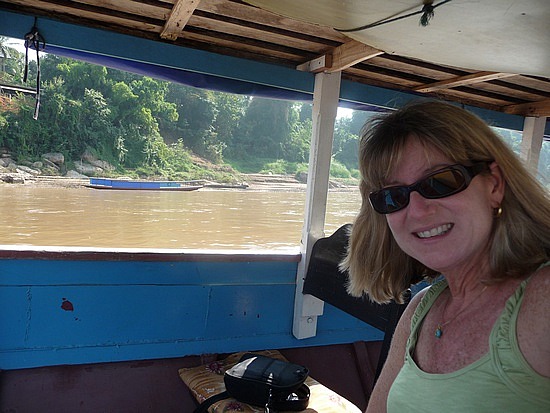
I left the Palace around noon and decided to stop for lunch before heading back to the hotel to meet my boatman for my trip on the Mekong and the Pak Ou. Any more exploring would have to wait a day. Before I headed down the street in search of lunch, I pull out the map that the folks in my hotel had very kindly provided. The map was specially made for the hotel (more about this fantastic hotel later), which included restaurant recommendations. I decided to try the Coconut Garden on the main street in Luang Prabang. There were only a few patrons in the restaurant, but I took a seat and placed my order. Twenty minutes later I had Mekong seaweed, a chili paste and a fish and pork dish cooked in banana leaves set in front of me. Quite frankly, this turned out to be not only the best meal I had in Luang Prabang, but the best meal I had in Southeast Asia. The fish and pork combination in the banana leaves had a slightly smokey flavor and was so. so delicious. The combination with a bottle of Beer Lao was absolutely brilliant!
I made it back to my hotel in time to meet my boatman (his name escapes me, but it started with a K and was incredibly long). We walked down the stairs to the Mekong and I got into the very tippy boat. (The boats that ply the Mekong are typically very shallow boats and as a result it does not take much to tip them over.)

My boatman got in and after bobbing back and forth, started the motor and we were off. The weather was perfect and fortunately, I was under a canopy so it was not too hot. We puttered along and passed a series of hillside gardens, more monks than I could count walking along the banks of the river, a few other boats returning from a morning trip to the caves and lots and lots of fisherman. It was a very relaxing trip.
We reached the caves and I hiked up the hill to the top caves. I paid the entrance fee of 20,000 kip (about $2.50) to a young girl of maybe 14 or 15 who initially said the fee was 20,000 and then changed her mind after she handed me the ticket and tried to tell me it was 30,000. I looked at the ticket that said 20,000, gave her 20,000 and shook my head. (I wonder how many tourists don’t pay any attention and pay the little “entrepreneur” 30,000 or more?)
Anyway, I wandered into the cave and immediately decided that my hotel folks were right. The caves were a joke. Just a bunch of dirty Buddha statutes sitting on some ledges. No big deal. I had only really wanted to go on the Mekong for the ride itself anyway and not the caves. I checked out the lower caves and determined that it was much of the same and headed back to the boat.

We started the trip back as the sun began to set. Since we were driving with the current, our two hour trip to the caves would be cut in half for the return trip, so we would reach Luang Prabang at sunset. Perfect, as I had been told the Mekong was the place to be at the end of the day. As we puttered along, my boatman started to talk to me. He was a friendly sort of guy so we chatted for a bit about life in Luang Prabang, my hometown, my job and so on. And then it happened. “So you married?” “No, I’m not married.” “Why you not married? You not like men?” If I had been drinking any sort of liquid, I am certain it would have been one of those incidents where it would have been spewn everywhere. I laughed and laughed. Finally, when I managed to stop the convulsions of laughter I got out “Uh no I like men very much.” “OK why you not married?” “Uh… very complicated. Long story.” “You tell me.” “Uh no thank you.” (This was without a doubt the nosiest boatman around. Most Lao folks are very shy so it was just my luck I would get the one without any inhibitions.)
Anyway, after fending off more prying questions and what I am quite certain was a weak attempt to have me join him for a drink, we cruised along and made it back in time for the sunset. It had been a wonderful, although slightly strange, boat trip on the Mekong and I had thoroughly enjoyed myself (apart from the personal questions).
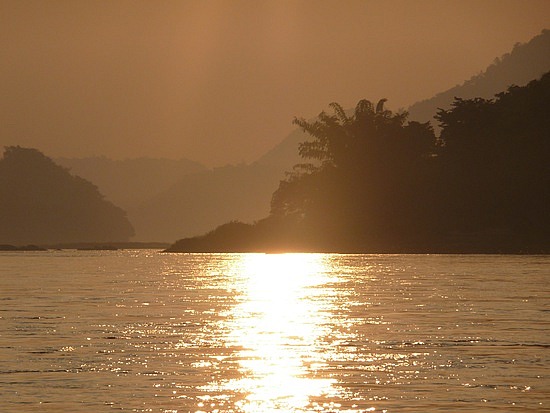
So next morning I got up very early for my trip to the All Lao Elephant Reserve, which rescues elephants from labor camps in Laos. Elephants are indigenous to Laos, but many of the country’s elephants are captured and either poached or domesticated for use by rural communities for a variety of purposes including logging, land clearance and agricultural use and transportation. When the elephants become older, the villages often abandon the elephants. Conservation groups have been trying to save these elephants and many of the abandoned elephants are placed in reserves where they are cared for. These groups ask for donations and in return, you can visit the camps and ride the elephants through the jungle. I had signed up to visit one such camp and for a chance to ride an elephant.
So I reached the camp at 8:00 a.m. and met my “rescue” elephant Bhune Tem, a 15 year old female who appeared to really enjoy just munching bamboo and bananas more than anything else. She was very gentle and did not appear to mind when I got on her back. As we began our VERY slow plod through the jungle area to river, I thought back to my camel ride in Egypt and realized that elephants are far more comfortable to ride than camels. Anyway, as we moseyed through the jungle, Bhune Tem must have made three pee stops along the way, and I must say it sounded like I was sitting atop Niagara Falls. My God!
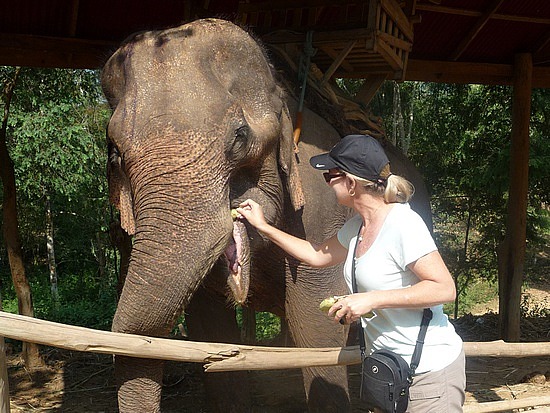
Anyway, after making our way up and down ravines and through a brook to the river for a small drink, we started our return trip. Bhune Tem climbed up the hill through a village and slowly plodded back into the camp. Once I was helped off Bhune Tem, I was allowed to feed her bananas, which she gladly took from me by using her big slobbery tongue. It was awesome!
When I got back to the hotel, I decided I wanted to try and find a silk weaver where I could buy some scarves and some materials so that I could have some skirts for work. I mentioned this to the folks in my hotel and ten minutes later, I was in a tuk tuk heading to the village of Xangkong to meet Tadem who has her own weaving shop. Twenty minutes after we set out, I was deposited in the village and wandered down the dirt road to find Tadem’s shop. After showing her card to a couple of people (who spoke no English), I was motioned to keep going down the road. I finally stumbled on her shop where a weaver was seated spinning thread in the outdoor shop out front.. I found Tadem in the back and she immediately showed me an array of scarves and materials. After sitting and having some tea and negotiating a bit, Tadem and I struck a deal. She wrapped the materials and scarves and I was back down the road to the waiting tuk tuk and the bumpy ride back to my hotel.
I then borrowed a bicycle and decided to head down to the dock area behind the Palace to see if I could hire a boatman for a quick trip across the river to the village of Ban Xiengmane. The hotel folks had recommended the trip and advised me that while the village was only a 5 minute boat trip from Luang Prabang, the village was light years from the modern conveniences found in its sister city across the Mekong.

It took no time to find a willing driver and before I knew it, I was standing on the banks of the Mekong on the opposite side of the river from Luang Prabang. (Thankfully this boatman did not ask me any questions about my marital status.) Anyway, I made my way up the dirt embankment to the stairs and climbed to the top of the hill. I planned to wander through the village to two temples and then double back.
As I walked through the more modern part of the village (their were cobblestones and homes with four walls as opposed to three walls, which I saw in many of the village homes as I wandered), I encountered some young boys playing soccer. One of the youngsters was quite good, balancing the ball and kicking it mid air. Rather impressive.
Anyway, as I walked down the main road, the tiny road changed to dirt and grass. Chickens and goats wandered all around me, men and women cooked on outdoor fires and … children came running asking me for pens. ****! I had read that the children in the villages are short on school supplies and are always in need of pens and pencils. I had completely forgotten and had come armed with nothing. I searched my bag and came up with two pens. I gave both away and felt bad for the rest of the afternoon that I had nothing else to offer the kids.

As I wandered towards the first temple, I passed a family scavenging for wood, which they would use to cook on their outdoor, open air fire. I then passed three very, very young children (maybe 5 or 6) carrying empty beer bottles which they can turn in for 5 kip per bottle (there are 8,000 kip to a dollar so you do the math). This was an extremely poor area and indeed a stark contrast to Luang Prabang.
I finally reached the first temple, Wat Long Khun, which was surrounded by trees and included beautiful statutes on the grounds as well as monks’ quarters. The temple itself was beautiful and featured a portico with Buddhist murals. Inside the temple there were murals dating to the 18th century. Apparently, prior to a Laotian king’s coronation he would spend three days there at a retreat. It was certainly a beautiful place to spend some time (and a rather stark contrast to the poverty I had just passed in the village).
I retraced my steps and climbed the hill to the second temple, Wat Chomephet, which had two beautiful stupas, fantastic views to Luang Prabang and a dismal wreck of a temple. Oh well. The climb of all 126 steps (I counted them) was worth it for the views alone.
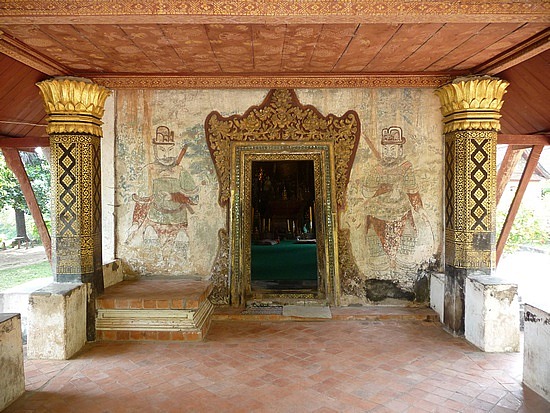
I climbed back to the bottom of the hill and headed back towards the waterfront and my boatman. However, as headed towards the water I encountered probably one of the funniest and certainly cutest sites I have seen on my trip to date: three young boys with their backs to me singing their little hearts out and playing improvised musical instruments. One boy had a circular metal pan and metal sticks he was using as a drum, another boy had two plastic bottles he was beating against a rock and another boy had two plastic antifreeze bottles he was also beating on with some wooden sticks. It was absolutely priceless and just goes to show that the passion for music is universal.
The site of the young boys and their little musical show had me smiling all the way back to Luang Prabang. I unchained my biked and rode back to my hotel and as I approached, I heard … more music. Only thing time it was coming from the Wat Xieng Thong, out neighbor temple. There were gongs and chimes and drums. This was the same music that had awakened me at 4:00 a.m. that morning. I wandered up the stairs, paid the entrance fee (I had already been to the temple with At, but I really wanted to see what was going on), and walked towards the back of the temple. The music room was filled with novice monks banging on all sorts of instruments in a rhythmic beat. I soon learned it was Buddha Day (although no one could explain to me what Buddha Day was) and that was the reason for the music at 4:00 a.m. and 4:00 p.m. O.K. then.

So I sat down and proceeded to listen to the concert for the next 15 minutes. While I was watching, one of the young novice monks banged a gong (not to be confused with T Rex and Bang a Gong) so hard he sent it crashing to the floor. The young novice monks all started laughing while continuing to try and play. The culprit bent down quickly put the gong back in its place and continued to beat on it all the while giggling. It was a rare chance to see the monks without their “game faces on”.
Also as I watched, one of the younger novices stepped in and began to hit the gong. It appeared he was learning as one of the older monks was standing near by helping him. The young fella was trying to be very serious, but he kept breaking out his smile and it was magic. It literally lit up the room he was in. I could not stop watching him, and I was rather sad when the music suddenly (and regrettably) stopped and the monks filed out. It had been a real treat.
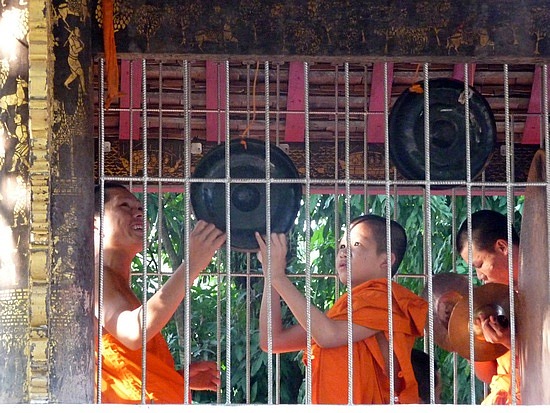
I decided to make it an early night because I was planning to get up at 5:45 to walk down the street to see the “alms giving” ceremony. As I said before, I had mixed feelings about viewing the ceremony. On the one hand, I really wanted to see this peaceful, humbling tradition for myself. On the other hand, I felt like it was a huge invasion of a religious customs, which I felt certain most tourists did not understand or appreciate. Anyway, the folks in my hotel told me that I could watch the ceremony in relative quiet on a side street near the hotel. So I decided when in Rome….
So at 6:00 a.m., I was wandering up the hill and down the street to find an out of the way spot where I could watch and take a couple discrete pictures. I found the perfect location about half way down the block on the opposite side of the road from where the monks would pass in front of the people who would pay their respects and provide the daily alms to the the monks as they passed by.

By 6:15 a.m., the first group of monks approached and it was absolutely silent as the monks shuffled past each resident who had decided to get up and offer alms (a handful of sticky rice) to each of the monks. (There were surprisingly few residents on the street, which made me wonder how do they guys get enough to eat?) Anyway, I finally worked up the nerve to take a couple pictures when … what the hell? A group of 30 people (obviously a tour group) had wandered up the block onto the street near where I was seated and took up a spot in the middle of the road right where the monks were to walk. They were talking and laughing, and I could see the residents across from me were none too pleased. I decided I could not stomach watching this spectacle so I got up and wandered back down the street towards my hotel.

As I walked, I decided to stop about 100 feet from the end of the block. There was nobody else around (other than four residents across the street who were waiting for the monks), and I thought I would give it one more chance. Soon the remainder of the monks soon filed past in silent, solemn single file formation. As I watched, I realized my original inclination had been correct. I felt like a voyeur in this solemn morning ritual. I had no business being there. I was not a Buddhist. I did not completely understand Buddhism or the ritual of alms. I had no business sitting on the street and intruding on this religious ceremony.
As I pondered my uneasiness, a moment of humor interrupted my thoughts. A monk near the end of the procession passed in front of me trailed by a lone dog. The sight was very funny and added a moment of levity to my serious mood. In fact, I even managed to capture the moment on film and was able to show the picture later in the day to a couple of young monks who found the picture hilarious.

Anyway, I headed back to my hotel for some breakfast before my trip to some local villages. Now about my hotel. Service in this hotel is second to none. Nothing is too much trouble for these folks. They will ferry you in the golf cart wherever you want to go. They will make reservations at a spa. They will find a boatman. They will loan you bikes. They will take your laundry and have it cleaned, dried and pressed in a couple hours. They keep the hotel spotless. The beds are tempur-pedic mattresses (which I have at home) and are covered with a featherbed. It is like sleeping on a cloud. And the breakfasts. Oh my God! There is a buffet coupled with made to order eggs and crepes, and the food is fantastic. I had THE best French crepes with banana and vanilla sauce. (In fact it was so good that I had it all 4 mornings at the hotel.)
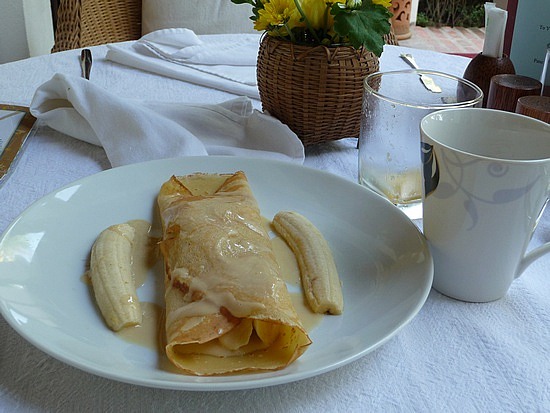
So after breakfast, my guide “Kop” arrived and we began the drive into the hills to visit both the Khmo and Hmong villages. The Khmo and Hmong are different ethnic groups in Laos and we were going to a couple villages that rarely see tourists. I had gathered up some pencils from town and Daniel, the manager at my hotel, provided me with multiple additional packets of pencils that were left by some other tourists who ended up being sick the day they were to cross the Mekong to visit the Ban Xiengmane village.
We drove through Luang Prabang and then onto a very bumpy dirt road that lead into the hills above Luang Prabang. We passed through villages, rice paddies, tropical forests and hillside farms with cows and water buffalo wandering the roads. After about two hours of driving we finally reached the Khom village. The primary differences between the Khmo and the Hmong lie in the customs of each ethnic group, the style of clothing and the style of home. The Khmo house is built on stilts and dinners are cooked outside on an open fire. A Hmong house is built on the ground and all of the cooking is done indoors on an open fire. I wasn’t sure why the Homng would want to subject the family to all that smoke, but apparently the houses are well ventilated according to Kop.

We wandered through the Khmo village and watched a group of girls playing a game with sticks and a ball (yep, pick up sticks only the girls were using what appeared to be hand made sticks instead of manufactured pickup sticks). The boys on the other hand were brawling in a friendly sort of way. (Kids are the same all over the world!) We wandered through the village and watched a man weaving a basket and women setting rice out to dry (it was harvest season). Most of the villagers were apparently in the fields so it was very quiet.
We got back in the jeep and drove the short distance to the Hmong village and sure enough … as we drove, we passed a number of villagers in the rice fields cutting down rice stalks and hauling stalks for processing. When we reached the Hmong village a few minutes later, the differences in the two villages were readily apparent both in the style of house as Kop had described, but also the amount of land and space that each home occupied (much more than the Khmo).

As we walked down a path, I saw some children polk their head out of a door of a house and I waved. (Lao children like their parents are quite shy.) Anyway, they immediately shut the door, but as I walked near the house, the door opened, and I was motioned to come inside by the mother. (I soon learned this was one of three mothers in the home as the Hmong men take multiple wives and they all live together “happily”. Mmmm….) Anyway, the young woman was making popcorn (seriously) over an open flame on a dirt floor in the house. The children were all gathered around the pan and I watched as she shook the pan over the fire.
I smiled awkwardly at the children as they all stared at me. The woman pulled a very low stool out and motioned for me to sit down as she pulled the popcorn off the fire. I folded my hands beneath my chin and gave a small tilt of my upper head (a traditional Lao way of giving thanks) and sat down. She then pulled out a small plate and immediately dumped some popcorn on the plate and offered it to me, which I accepted. She then set the remainder of the pot on the floor for the kids who immediately dove in. The popcorn was delicious. Fresh corn had been dried and used to make the popcorn and what a difference. No processed stuff here.
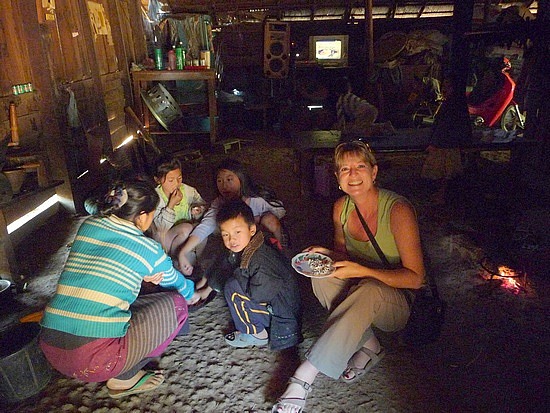
After eating the popcorn, I got up, thanked my hostess and her family again and wandered through the rest of the village. As we got back to the car, I remembered the pencils. I pulled them out of my bag in the car and told my guide I wanted to give them to the family who had been so kind to me. However, he told me it was a Hmong tradition to share so I would probably be expected to pass some out to all the children. Fine by me. So we returned to the home with pencils in hand and my guide told the family what I would like to do. The kids lit up and were clearly excited about the prospect of pencils. (It turned out one of the young daughters in the house was a very good artist. Her drawings were really well done.)
So I ended up sitting on a wooden sitting area outside, and I began the process of handing out two pencils to each child. It was like I was Santa Clause. Within minutes, I was surrounded by little ones. The adults instructed the children to line up and each one did as they were told, held out their little hand and I gave them their pencils. The children clutched the pencils like they were gold. It was wonderful and heartbreaking all at the same time to see an object that is so common in North America have such value in this wonderful, developing country.

It turned out I had a packet of push pencils that Daniel had given me, so I made it clear that I would like to gift those to the family who had opened their door to me. The five children were each given one of the pencils in addition to the two regular pencils, and I had to show them how the pencils worked. It was quite a scene.
Anyway, with gifts doled out, Kop and I took our leave. As we drove off, I saw two youngsters holding their pencils like a prize as they walked along with their mother. It was really something else to experience.
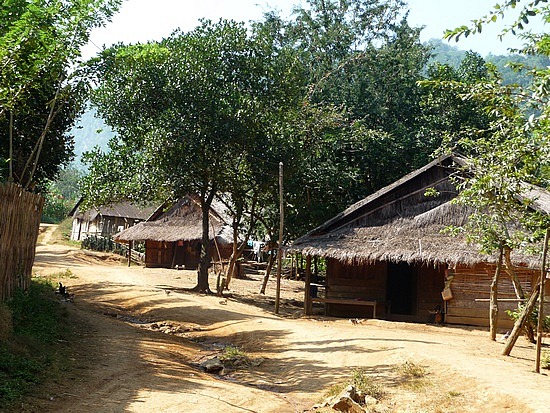
So Kop and I drove back down the hill and made our way to the Tat Kuang Sit waterfalls, which is 32 km south of Luang Prabang. The site is renowned for its multiple tier waterfalls, pools and trails. I wanted to visit the waterfalls and hike the trail to the top of the falls. So I left Kop at the bottom and told him I would return in a couple hours. I wandered along the path through the trees past gorgeous small waterfalls and crystal clear pools covering limestone rocks. It was lovely.
I reached the base of the giant waterfall and looked to my right straight up at the climb in front of me. Yikes. This was going to be tough. But never one to give up, I started the climb. It was literally like climbing a mountain as I had to grab rock ledges and hoist myself up to the next level. I had read about the hike, but there was no mention about how difficult it was. This was brutal. The rocks were slippery and covered in moss and the grade was very steep. After briefly (and I mean really briefly) contemplating turning back, a fellow passed me on the way down and told me it was only another ten minute climb.
I forged ahead and finally made it to the top only to discover that I had to step on rocks to get over numerous streams. Clearly my Keens were going to get wet so what the heck. I didn’t even bother to step on the rocks and just waded through the streams to finally reach the top of the falls. The view was magnificent and I ended up wading in to the edge where I could hang on to a railing and walk across the top of the falls. It was fantastic. Then the good news … apparently I had hiked up the tough trail and there was a much easier trail I could have used to get up and back. I know what I am using to get down!

So after spending 20 minutes or so at the top, I hiked back down with a young Scottish couple and we all safely reached the bottom. However, as I walked back down the trail from the base of the large waterfall past the numerous smaller waterfalls, I slipped and fell right on my butt. Unbelievable! I hiked all the way up to the top of the falls and back down without an incident and then I slip on some lowly little rock on a virtually flat surface.
I reached the entrance area, found Kop and we headed back to Luang Prabang. It had been a wonderful day, but I was now a little sore and decided I would like to partake in a Lao massage. Once back at the hotel, I had the staff make an appointment for my and minutes later I was in a golf cart heading for my massage.
Now the massage was rather different to say the least. I was instructed to lie on a mat on the floor and the young masseuse proceeded to put her full weight on every pressure point in my body. In addition, she bent my arms and legs like pretzels as she stretched and pushed me in every direction. The whole idea, apparently, was to help increase my blood flow and to help my muscles heal after a strenuous day. Unfortunately, it was a little (ok a lot) uncomfortable and not at all what I had hoped for.

So after the “massage” I decided to walk back to the hotel as dusk set in, and as I walked, I wandered past Wat Non Sikhounmuang temple. As I passed the gates, two young novice monks said hello to me and wanted to know where I was from. “Won” (as in number one he informed me) was the more talkative of the two and told me he wanted to practice English. Won wanted to know if I would mind talking to them for a bit. What was initially going to be a short conversation turned into a one hour discussion about life in the temple, the weather in North America, my job, what the U.S. is like, education and my life. Then I asked him a number of questions about life in the temple, his education and whether he wanted to be a monk (the answer was no … Won told me he wanted to go to university, be a teacher and get married and he said the last bit with a very shy giggle).
Anyway, as we chatted, I got around to a question that had been on my mind since arriving. What did the novices and the monks think about the tourist spectacle surround morning alms. Won immediately said with any hesitation that he did not like it at all. I then told him about my reservations and he agreed with me. He said that there were days he wakes up in the morning with his stomach in knots dreading the idea of walking through the hoards of people with cameras flashing. And he took it a step further and wondered why tourists felt the need to take pictures of them as they wandered the streets.
I told him that the sight of monks on a street is not common in most countries so it was something unique that people wanted to memorialize. I told him that I had tried to take pictures of monks when they were off in the distance so I didn’t disturb them or when I wanted a picture I would ask. Then I suggested to him that every time a tourist wanted to take his picture or took his picture he should ask them to come and talk to him so he could practice his English. He liked that idea, although Lao people are so shy, I doubt that he would actually ever do it.
So after about an hour, I finally bid Won and his friend goodbye. He was a delightful young fellow and running into him was a wonderful way to end my stay in Luang Prabang. It was off to Siem Reap, Cambodia in the morning.
